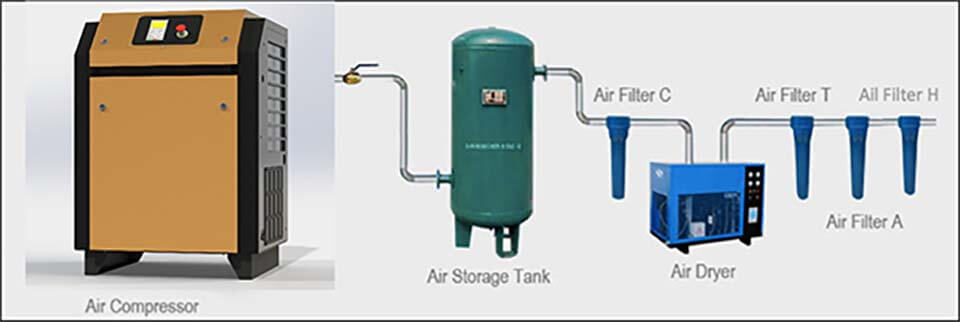Food Industry
Food Grade Air Compressor
Compressed air is widely used in the food industry and is the primary power source.
For example, many fruit and vegetable processing plants use compressed air systems for container cleaning, sorting, cutting, forming, filling, and packaging. In bakeries, we use compressed air to blow off the crumbs. For snacks, we use compressed air to generate nitrogen, which removes ambient air from the bag.
When choosing an air compressor for the food or beverage industry, our main concern is contamination to ensure your line’s compressed air is dry and clean. Your food needs to pass strict security checks.
Do you need
Do you need
for your non-contact low-risk food line?
We have more than 30 years’ experience.
Typical Applications of Food Compressors
| Item | What are the common applications for food safety compressors? |
|---|---|
| Sorting | In many fruit and vegetable processing plants, compressed air is used to power control valves and other pneumatic systems in automatic sorting equipment. |
| Transporting | For powdered products or raw materials, we use compressed air to push them through the pipeline, such as flour, milk powder, cocoa powder, etc. |
| Peeling and cutting | Peel fruits and vegetables like garlic and onions. Peel the nut shell. Clean and efficient. High-pressure compressed air can also be used to cut food. |
| Filling | During the processing of baked goods such as pastries, cakes, cookies, pies, etc., we need to use compressed air to fill delicious fillings. For drinking purified water, beverages, juices, milk, beer, cooling oil and other liquids, it is also possible to fill bottles or bags with compressed air. |
| Cooling | Baked goods need to be cooled when they leave the oven to preserve the quality and flavor of the food, and can also be packaged faster. Air knives used for cutting or peeling also require cooling on the production line. |
| Mixing | Using compressed air to mix dry food is clean, efficient and damage-free. |
| Packaging | Glass bottles are generally blown with a low pressure of 3~4bar, and PET plastic bottles are blown with high pressure of 30~40bar. For some PP plastic bottles, we usually use a pressure of less than 10bar to blow air. |
| Cleaning | For cans, bottles, bags, boxes and other food containers, can be cleaned with compressed air before filling. |
| Nitrogen Generation |
Air compressors can be used to produce nitrogen. The packaging of snack foods such as potato chips and shrimp chips uses nitrogen gas to prevent the product from being crushed Nitrogen is commonly used in food and beverage storage, for example to remove oxygen from packaging and prevent oxidation from affecting product quality and flavor. Nitrogen can also be used for air conditioning packaging (MAP); An inert atmosphere in food packaging is essential to ensure a long life. |
| Spraying | Compressed air is used to blow off crumbs in commercial bakeries. |
| Fermentation |
Providing oxygen for bacteria to produce food ingredients such as citric acid, wine and yogurt.
|
Food compressor quality requirements
In the food industry, compressed air should remove contaminants before use.
Common contaminants are solid particles, water vapor and moisture, and oil vapor. Mainly used for atmospheric pressure, oil-filled air compressors lubricating oil, pipelines, gas storage tanks, distribution, etc.
When compressed air comes into direct contact with food, purity and cleanliness must be guaranteed to prevent contamination. Specifically, what we should do is as follows:
Remove Moisture
Moisture is known to favor the growth of microorganisms and fungi. If there is moisture in the compressed air line, it can easily be blown onto food, packaging, or containers. In addition, compressed air with water can also breed microorganisms in food. So we need to use a dryer to guarantee the desired dew point. Generally, the dew point of compressed air in direct contact is -40°C, and a desiccant dryer is used. Low-risk non-contact compressed air has a dew point of 3°C and uses a freeze dryer.
Remove Oil
There is oil in the atmosphere, so even if you choose a 100% oil-free air compressor, there will still be oil vapor in the compressed air, so a filter should be used. Typically, a 100% oil-free air compressor must be used for direct contact with compressed air. For low-risk non-contact compressed air, we can use more economical oil lubricated air compressors, but it is best to use a filter to ensure 0.003ppm oil content.
Remove Particles
The atmosphere contains solid particles or dust that can cause contamination if it comes into contact with food. Other contaminants can come from the internal mechanisms of the air compressor system. We also need to use a filter to ensure that the particle content does not exceed 0.01μm.
General equipment for food applications
For direct contact with compressed air in food production lines, we recommend a 100% oil-free air compressor with a desiccant air dryer and filter, and food-grade stainless steel.
For non-contact, low-risk compressed air for food lines, oil-lubricated air compressors with refrigerated air dryers and filters can be an option if you’re on a budget, but oil-free air compressors are a good option in the long run The Select Run option is selected to run. Not only can high-quality oil-free clean air be produced, but maintenance and energy costs are low.

